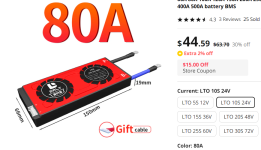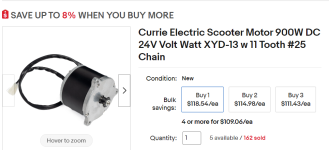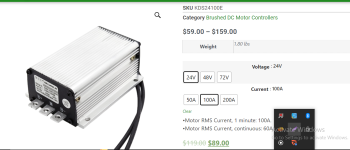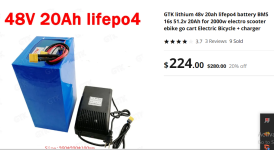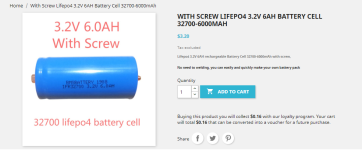Looking at ordering one in October and a second in November.
- Voltage: 52 V
- Capacity: 10 AH
- With Built-in High quality BMS ,Battery have overcharge, over discharge, over current, short circuit, charge equalization of automatic identification and protection circuit.
- Battery Size :88*145*260mm
- Type :LiFePo4 Battery pack
- Weight:5 Kg
- Standard Charge Current 3A
- Max Charge Current 30A
- Max Charge Voltage 58.4V DC
- Battery Resistance ≤10mΩ
- Rated Discharge Current 30A( can be customized)
- Max continual Discharge Current : 60A
- Pulse Discharge Current : 100A
- Discharge Cut-off Voltage :42.5V
- Charging method : CC/CV(Constant Current Constant Voltage)
- Lifecycles : More than 3000 times .
5 kilograms = 11.0231 pounds so 11 ponds for 10 Ah
20 to 22S LTOs are just too much weight for an e bike. The LTOs are 900 grams each so
900 * 22 = 19,800 grams to pounds = 43.651528 pounds so with boxes and hardware at least 45 pounds.
So the question is did I waste > $600 on those LTOs. The answer is NO.
The reason is simple. Most of my trips with an ebike is < 10 miles or about 6 to 8 miles round trip. I rarely travel 20 miles or 36 to 40 mile round trips but might in the future with two of those 10 Ah packs which will only be about 22 pounds. My 15 amp 54.6V portable AC charger will charge two packs in an hour or less to at least 85%.
- Max Charge Current 30A That is the rating for one 10S pack. 54.6V / 16 = 3.4V. Perfect for a quick charge to get home. I can then plug in the 58V 16S chargers that come with each pack for over night charging.
I am building a 10S LTO pack with a 5 amp active balancer and 10S BMS for full protection. I am leaving the two 6S LTO packs as is but adding active balancers and BMSs for full protection.
10S LTO = 19.8416 which is just shy of 20 pounds. 12S = < 24 pounds by just a little. 23.8 pounds. about 25 pounds with the boxes.
I have been wanting to order the Currie 24V 900 watt motor for a long time and am looking at around Christmas time and plan on ordering two. With a brush motor two can be run to a single wheel sprocket and single Kelly controller. I could even put a third in the front as 100 amp controller will easily run three 900 watt motors.
The bottom line is LTO is the perfect choice for 24 to 30 working volts as < 25 pounds and LFP for 36 to 52V as also < 25 pounds.
LiCo or Lion , LiPo may be 10 pounds less but the extra charge cycles and safety factor LTO and LFP make that 10 pounds worth it.
There is the perfect charger for 12S LTO. 33.6V at 10 amps.
I might as well make two 12S packs and use all the LTOs I ordered but only run one 12S pack at a time so 25 pounds of battery instead of 50 pounds. 12 * 2.8V = 33.6V. 4.2 * 8 = 33.6V. That is why that lion charger will work perfect for 12S LTO.
900 / 24 = 37.5 * 30 = 1,125W * 2 = 2,250W. Three motors will push 3,375 watts.
9/24/23 - 9:31 PM.
I found a 20 Ah LFP pack just now. I figured if they sell 10Ah then they should sell 20 Ah. Adding the picture below. Ordering it Friday. If it is as advertised it should fit all my 48V needs It is also less than 17 pounds.

- Voltage: 48 V
- Capacity: 20 AH
- With Built-in High quality BMS ,Battery have overcharge, over discharge, over current, short circuit, charge equalization of automatic identification and protection circuit.
- Battery Size :260*200*100 mm
- Type :LiFePo4 Battery pack
- Weight: 7.6Kg
- Standard Charge Current 5A
- Max Charge Current 30A
- Max Charge Voltage 58.4V DC
- Battery Resistance ≤10mΩ
- Rated Discharge Current 50A
- Max continual Discharge Current : 62A ( can be customized)
- Pulse Discharge Current : 200A
- Discharge Cut-off Voltage :42.5V
- Charging method : CC/CV(Constant Current Constant Voltage)
- Lifecycles : More than 6000 times .
I might still buy a spot welder but may wait until January 2024. Building packs could still land me a profit but a winter project.
I want to build a 24V ebike first and get BMSs and balancers for 12S LTOs + the 33.6V charger.
Skyler.


